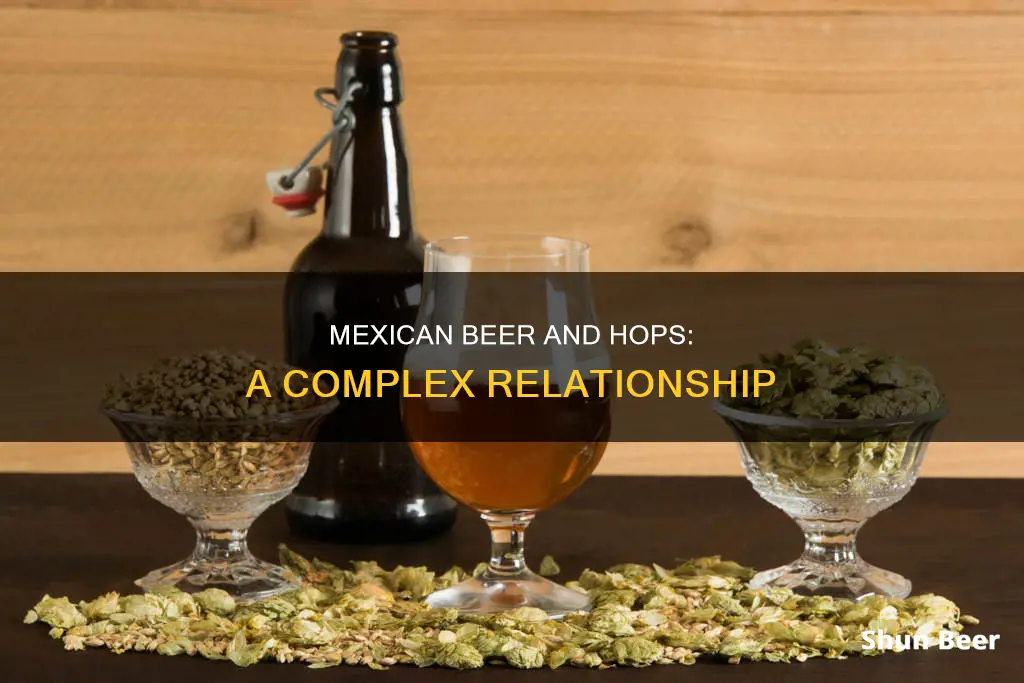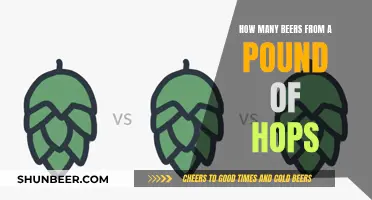
Mexican lager is a style of beer that can be interpreted in various ways, with brewers using different ingredients and methods to put their own spin on it. While Mexican beers typically use adjuncts for cost purposes, in Mexico, corn is king. However, hops don't grow in Mexico and have to be imported, making it hard to find much hint of hops in any mainstream Mexican beer.
However, hops are used in Mexican beer. German or Czech hops that are associated with European lagers are most appropriate for this style, but it shouldn't be heavily hopped. Hop varieties like Tettnanger, Hallertauer, and Saaz are often used, as are US-grown alternatives like Sterling, Santiam, Vanguard, Liberty, or Crystal.
| Characteristics | Values |
|---|---|
| Hop usage | Low to moderate |
| Hop type | Spicy, floral, herbal, noble |
| Hop varieties | Tettnanger, Saaz, Hallertau, Sterling, Santiam, Vanguard, Liberty, Crystal |
| Hop aroma | Light |
| Hop flavour | Spicy, floral, herbal |
What You'll Learn

Mexican lager is a subset of International Pale Lager
The Mexican lager style is controversial because it can refer to many different beers, but generally, it refers to a clean lager with low bitterness and high clarity, known as a Clara. Vienna Lager is also a key style in the Mexican Lager group, and the flavour profile of Vienna Lager has inspired many Mexican Lagers that are amber in colour and include adjuncts like corn/maize. However, Vienna Lager in its traditional form does not include this adjunct.
The modern (pale) Mexican lager came about in the 1920s and has its roots in the expansion and eventual control of international brewing conglomerates, who heavily marketed the beers and dominated retail distribution.
The BJCP style profile for International Pale Lager is quite broad, but it does encompass the premium mass-market lagers from most countries. The craft interpretation of Mexican lager fits nicely within that description but can be viewed more narrowly since it will almost always feature corn in the grist and tends to use a neutral yeast.
International Pale Lagers are pale in colour (straw to gold), tend to be highly carbonated, and are normally quite clear. The head is typically white in colour, but may not have great retention. The Mexican lagers are often deeper in colour, more in the gold range.
The aroma of an International Pale Lager has a lightly malty impression with a grainy or neutral malty quality. The Mexican lager adds a corny sweetness. International Pale Lagers often have a light hop aroma, typically featuring noble-type hops that have a floral or spicy character. This is also the case with Mexican lager – its European roots call for quality European aroma hops.
International Pale Lagers are crisp, dry, and well-attenuated. The malt flavour matches the aroma and can be neutral, grainy, lightly malty-sweet, or crackery. Mexican lagers have a similar profile, but bring in a corny sweetness and flavour. While the alcohol level in an International Pale Lager can go as high as 6% ABV, most are in the 5% range. I think the Mexican lager works best in the 4.5% to 5.5% range.
Icehouse Beer: Hops or No Hops?
You may want to see also

Mexican lager is clean, with a restrained bite
Mexican lager is a beer style that has gained popularity over the last few years. It is a refreshing and drinkable beer, perfect for a hot day. While there is no defined style, it is typically a pale lager with restrained flavours and a clean, crisp finish.
The key to a Mexican lager is its drinkability and it is often described as a refreshing beer, perfect for a hot day. It is a versatile beer that can be interpreted in various ways by brewers, with some putting their own spin on it by using different ingredients and methods. However, it is generally a clean lager with low bitterness and high clarity, known as a Clara.
The origin of the Mexican lager can be traced back to the 19th century when Austrian and German immigrants settled in Texas and Mexico, bringing with them beer recipes that were similar to Vienna Lager. Over time, these beers evolved and Mexican brewers began to use corn in the grist, which is now a traditional ingredient in Mexican lagers. The use of corn, in the form of flaked maize, enhances the crispness of the beer and also reduces the cost of the malt bill.
When it comes to hops, Mexican lagers typically have a light hop aroma, using noble-type hops with a floral or spicy character. German or Czech hops associated with European lagers are most appropriate for this style, with varieties like Tettnanger, Hallertauer, and Saaz being popular choices. The hopping is not heavy, with a target of around 15-20 IBUs, and the late hops addition provides a unique lime-like flavour without the acidity of actual lime.
In terms of malt, Mexican lagers use lightly-kilned base malts such as Pilsner, Vienna, and Munich malts. The percentage of corn in the grist will also impact the flavour, with a higher percentage resulting in a more dominant corn flavour. The water profile should be relatively neutral, as a minerally flavour is not desired in this style.
The fermentation process for a Mexican lager is cold, as it is a lager, and the yeast used can vary. White Labs offers a Mexican Lager yeast (WLP940) which is said to have an unmistakable flavour associated with commercial beers from Mexico. However, this yeast may not be widely available, so a neutral lager strain or an American Ale yeast can also be used.
Overall, the Mexican lager is a versatile beer style that is perfect for warm weather. It is characterised by its restrained bite, clean finish, and easy drinkability. With its increasing popularity, it is a style that is worth exploring and brewing, especially during the summer months.
Apple Cider Beer: Hops or No Hops?
You may want to see also

Mexican lager is made with German or Czech hops
The use of hops in beer can vary depending on the style and origin of the beer. Hops are a key ingredient in beer, providing bitterness, flavour, and aroma. Different varieties of hops can be used to create different flavour profiles in beer.
The history of Mexican lager dates back to the 19th century when Austrian and German immigrants settled in Texas and Mexico. The beer recipes they brought with them were similar to Vienna Lager, and for many years, Vienna and Vienna Lagers brewed with maize were the standard in popular commercial Mexican beer brewing.
In the late 1800s to early 1900s, brewers that either worked or trained in the United States brought this type of brewing to Mexico. One of the first lager breweries in Mexico was Cervecera de Toluca y México, founded in 1865. The brewery was able to import the first ice machine into Mexico, allowing them to produce the first lager in the country.
Today, Mexican lager is a popular style of beer that is enjoyed worldwide. It is known for its light and crisp taste with notes of citrus or honey, along with a slight sweetness from the malt. Mexican lager is often carbonated more highly than other lagers, giving it a characteristic fizzy mouthfeel.
Beer Hops Allergy: What You Need to Know
You may want to see also

Mexican lager is hard to find in stores
However, this doesn't mean that Mexican lager is impossible to find. Here are some tips to help you locate and purchase this beverage:
- Check local microbreweries and brewpubs: Mexican craft beer is growing, and local microbreweries and brewpubs are making amazing beers of all styles, including Mexican lager. When travelling to Mexico, it can be a fun challenge to find a beer that isn't brewed by FEMSA or Modelo. These smaller breweries often have unique and innovative offerings that are worth seeking out.
- Look for specific brands: Some popular Mexican lager brands that you may be able to find in stores include Corona Extra, Modelo Especial, Dos Equis, Tecate, and Pacifico. These lagers are widely distributed and may be more readily available than smaller, independent brands.
- Shop at specialty beer retailers: If you have any specialty beer retailers in your area, they may have a wider selection of Mexican lagers than typical grocery or liquor stores. These shops often cater to beer enthusiasts and may carry a broader range of craft beers, including Mexican lagers.
- Order online: If you can't find Mexican lager in local stores, consider ordering from an online retailer that specialises in craft beer. This way, you can access a broader selection of beers from different breweries, including those that may not be distributed in your area.
- Visit Mexico: If you're planning a trip to Mexico, take advantage of the opportunity to sample local Mexican lagers. You'll be able to find a wider variety of options, including those from smaller breweries that may not export their products.
Remember, when purchasing Mexican lager, it's worth supporting local microbreweries and independent brands to promote diversity in the beer market and encourage innovation.
Hops' Role in Brewing: Aromatic and Bitter Beer Balancing
You may want to see also

Mexican lager is often served with a lime
Another theory suggests that limes were originally used to remove rust from the metal caps of beer bottles, which could leave a ring of rust on the rim. Wiping the rim with a lime wedge became a common practice to remove the rust and sterilise the bottle. Additionally, the citrus fragrance of limes can act as a disinfectant, which would have been particularly important considering the deleterious effects of drinking water in Mexico on health.
Limes may also have been used to keep flies away from the beer, as open-air bars and beachside locations would attract insects to the sugars in the drink. The addition of lime also adds a tangy, crisp, and refreshing flavour to the lager, making it particularly well-suited to summer weather and outdoor activities.
Finally, one more contemporary theory suggests that in 1981, a bartender in California made a bet that he could start a new trend by simply putting a lime into a bottle of beer. This trend caught on, and today, it is hard to imagine drinking a Mexican lager, especially Corona, without a lime wedge.
Grow Your Own Hops for Beer: A Step-by-Step Guide
You may want to see also
Frequently asked questions
Yes, Mexican beers do contain hops.
German or Czech hops that are associated with European lagers are most appropriate for this style of beer. Hop varieties include Tettnanger, Hallertauer, and Saaz.
Mexican beers were first developed in the 19th century when Austrian and German immigrants settled in Texas and Mexico, bringing with them beer recipes that were similar to Vienna Lager.
Some popular Mexican beer brands include Corona, Modelo, Pacifico, Dos Equis, and Tecate.
Mexican beers are often deeper in colour, with a gold range. They also tend to have a corny sweetness due to the use of corn in the grist.







